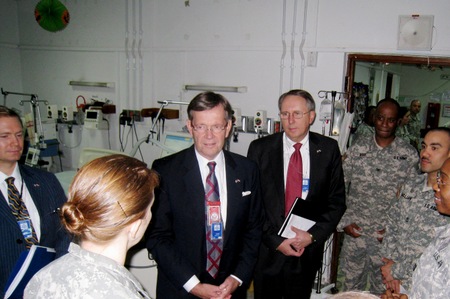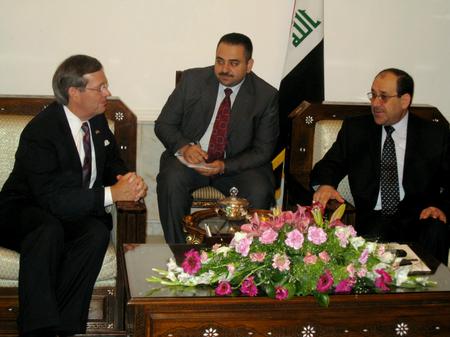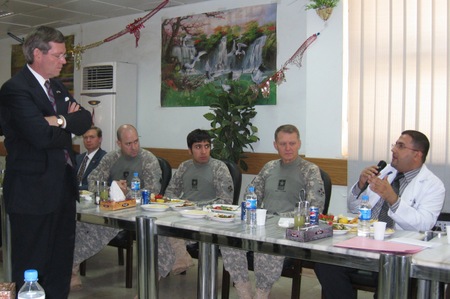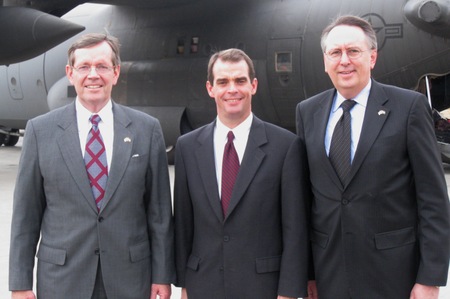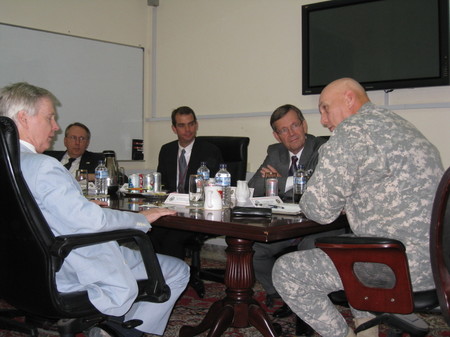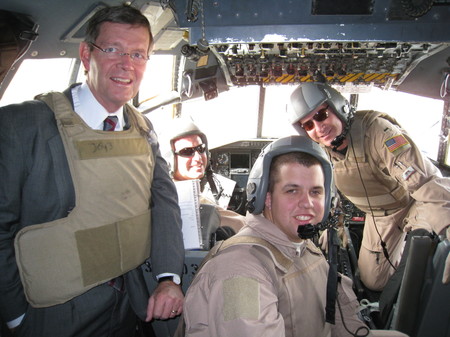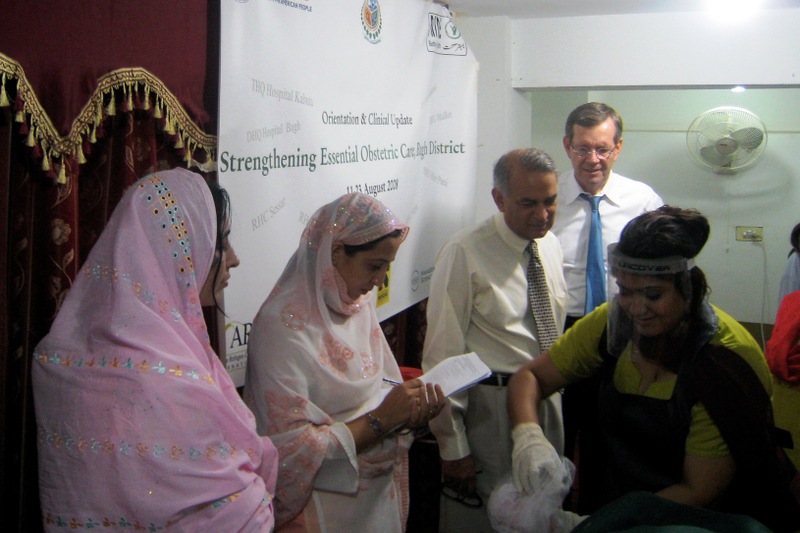The past weekends were full of disaster preparation. In previous blogs, I have talked about the competence of the people who manage disaster response in our country and the substantial increase in our readiness in the three years since Katrina. That point of view has only been enhanced watching them manage emergencies in two successive weeks.
As Hurricane Ike moved closer to land fall in the United States, it looked to be a massively treacherous storm. When I woke up Friday morning, the words “may face certain death,” were being used by weather forecasters to describe anybody ignoring the evacuation advice.
Every few hours, I had a conference call among my advisors and emergency managers to update me on the storm. This storm, like Hurricane Rita in 2005, was dancing across the gulf, changing directions at least five times. Each time required responders to begin evacuating a different population. Late in the afternoon, it was evident that it would hit the Galveston and Houston area. The storm was projected to have category 4 winds and ocean surges as high as 25 feet, which would produce widespread disaster— serious disaster.
On the final call of Friday evening, our equipment, supplies and people were in place and all we could do was wait for the storm to pass.
Saturday morning at about five a.m., I got up to watch the early television reports. I was relieved as the morning passed to hear officials say that the massive surges being forecast were not developing. We deferred the call until noon so our command center could gain situational awareness and consider how our preparation needed to be altered.
During the noon call, it became evident there were a number of communities hit hard along the coast. We were well positioned with assets to meet the requests of the states. I got a report on our capacity to respond to the millions who had been evacuated.
By Sunday afternoon, we were discussing when I should visit the area. The decision was made that Monday would be too early, things were still playing out and that I would fly down on Tuesday morning, stay the night in Austin and return Wednesday, visiting four cities during the two days.
Monday morning, we woke to news that problems of another kind had been occurring during the weekend, the collapse of Lehman Brothers and sale of Merrill Lynch, signaling more dramatic fallout from the credit crisis.
My first scheduled event of the day was an arrival ceremony for the President of Ghana on the South Lawn of the White House. Because of HHS’s significant activities in Africa, I had been asked to attend. Following a meeting in the Cabinet room with President Bush and President Kufuor, we briefed President Bush on the storm in the Roosevelt Room.
The storm briefing was lead by David Paulison, the head of the Federal Emergency Management Administration (FEMA), with Sam Bodman, the Secretary of the Department of Energy, who discussed the impact the storm would have on the nation’s energy situation. My part of the report didn’t take long because our assets were in place and services were being provided as planned. At the conclusion of the meeting, Ken Wainstein, the President’s Homeland Security Advisor, asked me to accompany the President on Tuesday morning to the Houston area, so our travel plans changed.
I left the House at 5:50 a.m. for Andrews Air Force Base. As I walked across the tarmac, it was still pre-dawn. It is never that I see Air Force One and I don’t feel a sense of awe. It is such an inspiring symbol of our nation’s stature. It is shaped like any other 747, but there is something special about the remarkable power-blue color and the words United States of America.
Typically, those who accompany the President on these trips get into place about a half-hour before takeoff. It’s actually a very pleasant time. The plane is more like an office building than an airliner. It’s a place of work. There are small offices and a conference room as well as places for the news media to sit and work.
We arrived at an airport near Houston, spent a half-hour being briefed by Texas emergency management officials and then boarded helicopters so we could view the widest possible areas during our visit. One element of the briefing likely hasn’t seen much news coverage. The briefer told the President one significant issue the emergency management officials were having was animal problems. “Cows,” he said, “are running all over the place.” “And,” he continued, “a lion and two tigers on the loose.”
It turns out, some people in remote parts of the island had these wild animals as pets. Somebody wryly said, “Well, that probably takes care of the cow problem.” A good sense of humor in a disaster is always appreciated.
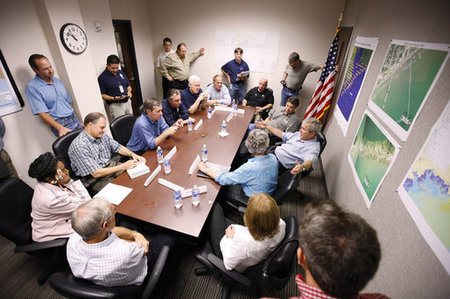
President George W. Bush speaks with state and local officials during a briefing Tuesday, Sept. 16, 2008, at the Galveston emergency operations center.
I rode, along with Governor Rick Perry and David Paulison of FEMA, with President Bush in Marine One (another fine machine and symbol).
I won’t attempt to duplicate news accounts, except to say that seeing damage like that is always more startling in person than on television. The scene I saw was reminiscent of Katrina, but not as universal as some of the areas of Louisiana and Mississippi at that time. I was not able to visit any of the flooding areas.
As they move from survival and rescue into recovery, the Mayor of Galveston, Lyda Ann Thomas, and her team were beginning to wrestle with public health issues. There were no toilets, or places to wash hands. Disease becomes a serious threat. I linked up to talk with David Lakey, the Texas Director of Public Health. I also discussed recovery resources with Governor Perry. The Texas team is a good one.
When I talked with the Governor on the phone earlier in the week, I simply said, “Well, here we go again.” They are battle-proven and confident. However, it was clear to me the Governor was worried that this one could be a monster. Fortunately, it was bad, but not as serious as it could have been overall.
The President had to get back to D.C. to deal with the financial crisis on Wall Street, which was unfolding as we moved. Occasionally, a reporter would shout a question about AIG, which was leading the news. The President reminded them he was dealing with a grieving Galveston right then. He would deal with that in Washington.
One cannot avoid being overwhelmed by the power of nature. Likewise, it is hard to understand why people build homes in some of the places they do. There were stretches of beach in and around Galveston where homes were not only destroyed, but also completely cleared of all debris. There was no sign anything had existed but a concrete pad.
There were some homes standing that had been built with a different code, requiring hurricane-resistant construction.
Once again, I will say the emergency responders were an inspiration. There are always things we can do to get better, and we’re getting better with each disaster. Texas was impressive. The mayors and their teams in Houston and Galveston were both impressive.
Galveston will be a long time recovering. In my view, homes on the beach areas of that region should not be rebuilt unless they are at a standard of construction that can withstand a powerful Hurricane. I also don’t believe the government should be heavily subsidizing property insurance, or offering big payouts after a storm for private structures in areas where they will obviously be blown away again by a hurricane.
HHS has deployed more than 1,600 people into the hurricane theater. The state of Texas is carrying most of the burden. We are now moving from rescue into a recovery mode.
I would also like to say what an effective operator I think David Paulison is. I’ve watched him for many months now. He’s direct and organized; doesn’t over-promise and is willing to solve a problem with a little ingenuity. FEMA is often the target of frustrated critics. Sometimes, FEMA probably deserves it. However, in an organization as complex as the combined national and state government emergency management system and in the middle of a disaster, there is bound to be some confusion and unpleasantness. With Paulison’s leadership it has been minimized.

